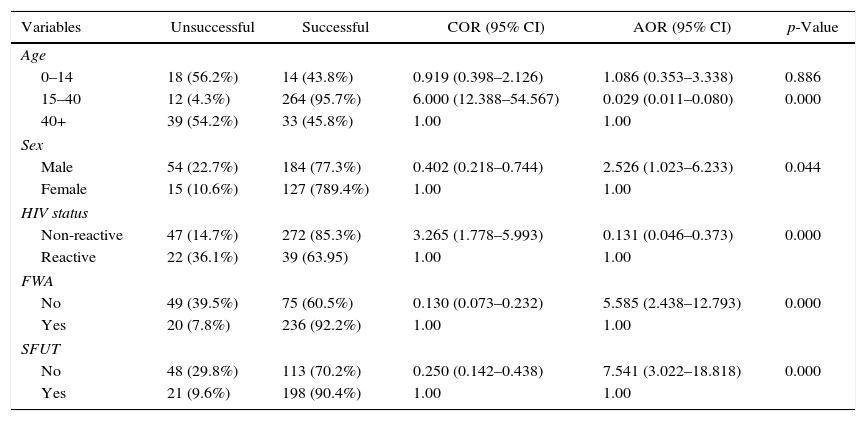Evaluating the outcomes of tuberculosis treatment and understanding the specific reasons for unfavorable treatment outcome are important in evaluating the effectiveness of tuberculosis control program. A retrospective study was conducted to assess tuberculosis treatment outcomes and associated factors among smear positive pulmonary tuberculosis patients in zone-one health facilities of Afar regional state, Ethiopia. A total of 380 smear positive pulmonary tuberculosis patients’ registration book recorded with complete information from Jan 2011 to Dec 2013 were analyzed. Of 380 patients included in the analysis, 238 were male and 142 female with mean age of 30.7. Overall treatment outcome were 128 (33.7%) cured, 192 (50.2%) completed, 17 (4.5%) died, 1 (0.3%) treatment failure, 34 (8.9%) default and 8 (2.1%) transfer out. Treatment success rate was 81.8%. There was statistically significance association between age (p-value=0.000), sex (p-value=0.018), HIV status (p-value=0.000), four week attendance (p-value=0.000), sputum follow up test (p-value=0.000), and treatment outcome year (p-value=0.000), and treatment success (p-value=0.000). Treatment success rate almost reached to the WHO targets although yet need to work a lot for fulfillment of global targets. Regular four week attendance in continuation phase and doing follow up sputum test with unsuccessful outcome for smear positive tuberculosis patient were vital.
Tuberculosis (TB) is the leading cause of morbidity and mortality in the world; it remains a major global health problem.1 The number of TB deaths is unacceptably high given that most are preventable if people can access health care for a diagnosis and the right treatment is provided.2 However, factors such as access to care and a person's social and financial situation might affect treatment outcomes. A retrospective cross-sectional study was carried out to assess treatment outcome of TB patients registered from Jan 2011 to Dec 2013 in zone one of Afar region, Ethiopia. Univariate and binary logistic regression analysis was done to identify factors that were associated with treatment outcomes (favorable or unfavorable). Ethical approval was obtained from the Health Science Research Ethical Committee of Samara University in Afar region, Ethiopia.
A total of 380 patients’ records with complete information were analyzed. A total of 238 were male and 142 female with an overall mean age of 30.7 years. The global treatment outcomes were 128 (33.7%) cured, 192 (50.2%) completed, 17 (4.5%) died, 1 (0.3%) treatment failure, 34 (8.9%) defaulted, and 8 (2.1%) transferred out. The overall treatment success rate was 81.8% (311). Among different health facilities treatment success rate ranged from 70.9% to 89.3%. This rate has improved with time. The variables age, sex, HIV status, four-week attendance, sputum follow up test, and year of treatment were significantly associated with treatment success (Table 1).
Logistic regression analysis of different factors associated with sputum smear-positive pulmonary tuberculosis patients in Afar region, Ethiopia.
| Variables | Unsuccessful | Successful | COR (95% CI) | AOR (95% CI) | p-Value |
|---|---|---|---|---|---|
| Age | |||||
| 0–14 | 18 (56.2%) | 14 (43.8%) | 0.919 (0.398–2.126) | 1.086 (0.353–3.338) | 0.886 |
| 15–40 | 12 (4.3%) | 264 (95.7%) | 6.000 (12.388–54.567) | 0.029 (0.011–0.080) | 0.000 |
| 40+ | 39 (54.2%) | 33 (45.8%) | 1.00 | 1.00 | |
| Sex | |||||
| Male | 54 (22.7%) | 184 (77.3%) | 0.402 (0.218–0.744) | 2.526 (1.023–6.233) | 0.044 |
| Female | 15 (10.6%) | 127 (789.4%) | 1.00 | 1.00 | |
| HIV status | |||||
| Non-reactive | 47 (14.7%) | 272 (85.3%) | 3.265 (1.778–5.993) | 0.131 (0.046–0.373) | 0.000 |
| Reactive | 22 (36.1%) | 39 (63.95) | 1.00 | 1.00 | |
| FWA | |||||
| No | 49 (39.5%) | 75 (60.5%) | 0.130 (0.073–0.232) | 5.585 (2.438–12.793) | 0.000 |
| Yes | 20 (7.8%) | 236 (92.2%) | 1.00 | 1.00 | |
| SFUT | |||||
| No | 48 (29.8%) | 113 (70.2%) | 0.250 (0.142–0.438) | 7.541 (3.022–18.818) | 0.000 |
| Yes | 21 (9.6%) | 198 (90.4%) | 1.00 | 1.00 | |
FWA, four-week attendance in CP; SFUT, sputum follow up test.
In the present study female patients were more likely to have successful treatment outcome compared to male patients (89.4% versus 77.3%; p-value=0.004). This finding is in line with that reported by Tessema et al.3 Patients aged more than 40 years old were more likely to have unsuccessful treatment outcome (p-value=0.000). Treatment outcomes in the present study were consistent with those reported by Tweya et al., which showed 86% of treatment success (completed plus cured), 5% died, 1% had treatment failure, 2% were transferred out, 6% defaulted.4 In contrast, treatment outcomes were rather distinct from those reported in a study by Tessema et al., in which 29.5% were cure+completed, 18.3% defaulted, 10.1% died, 0.2% had treatment failure, and 42.0% were transferred out.3
The overall treatment success rate of the present study (81.8%) is similar to that found by Hamusse et al. (83.6%).5
Conflicts of interestThe authors declare no conflicts of interest.






